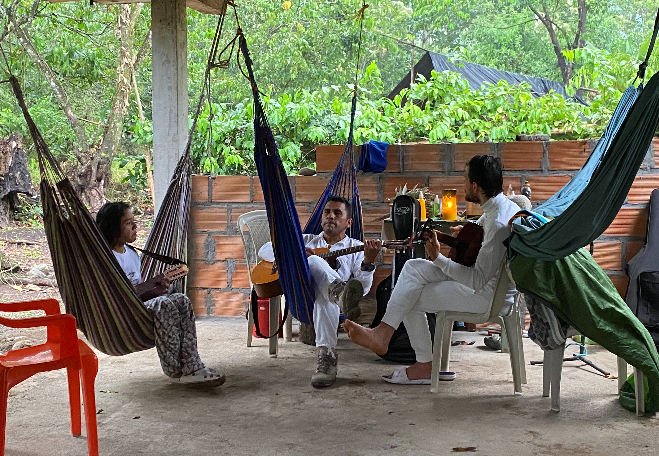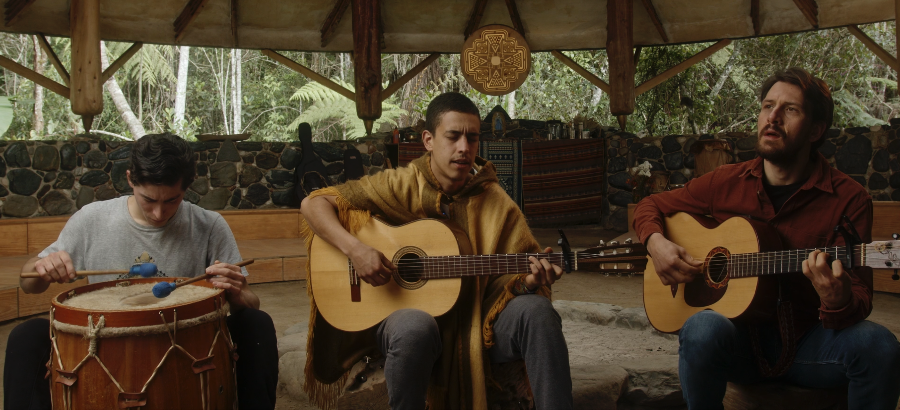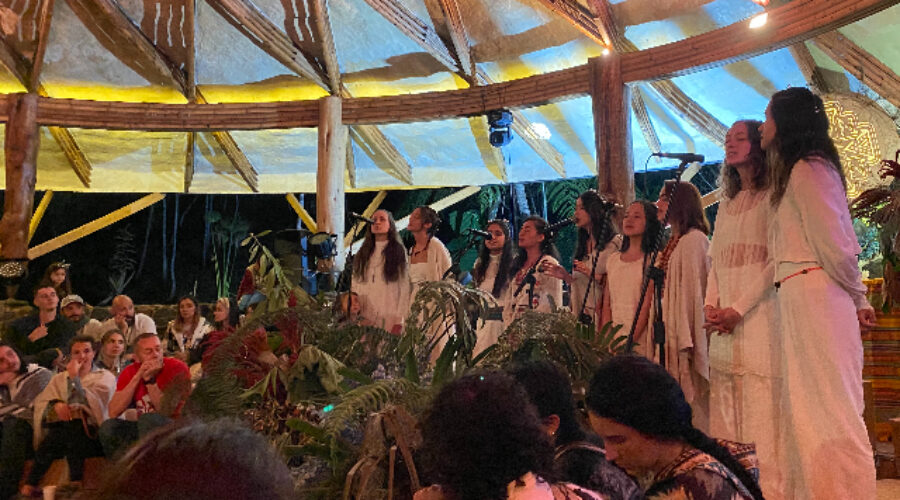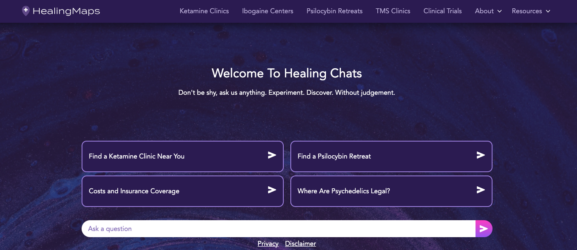Songs for the Soul: The Healing Power of Medicine Music
Have you ever sat in a ceremony, and felt like the music is touching something deep inside your soul? Have you ever listened to songs that were played during a ceremony you attended, and felt immediately connected to the healing vibration of the medicine you took?
That’s medicine music.
“Medicine music changes your life. It shows you your path. It’s a portal to connect with ancestral wisdom,” said Daniel Boukenooghe, a medicine musician and music teacher from Medellín, Colombia.
What makes medicine music so powerful–and can we learn to play it ourselves?

What Exactly is Medicine Music?
Native cultures have used medicine music to bring about healing, spiritual connection, and community gathering for thousands of years. They use medicine music inside and outside of plant medicine ceremonies to transmit messages of joy, peace, compassion, and healing. In its essence, medicine music is prayer clad in music, says Ivaylo Govedarov. Govedarov created a guitar course together with local Colombian medicine musicians.
Boukenooghe explained that medicine music comes from native people from the Americas, Asia, Africa, and Europe. These cultures developed ancestral sound “technology” that lets them enter elevated states, gather to dance and sing, and honor Mother Earth, he said.
Medicine musician Ayla Schafer explained in an interview with Songfacts, “So when we use sound, we are entering a conversation. We are working with that which the universe is made of, and that’s why it can be so powerful for healing, for moving things in the body, for praying. It’s a tool.”
Medicine music goes further and deeper than other types of music in terms of its healing effects on us. The frequency carried in medicine music impacts our bodies on a cellular level, studies suggest, and its lyrics can teach us about living a good life.
RELATED: What’s Crazy (And Not So Crazy) About Oregon’s Psilocybin Prices
‘A Deeper Message’
“I believe that music, in general, can be medicine, but, in the same way that conventional medicine often has a synthetic approach that is not natural – many conventional medicines provide immediate relief, but do not treat the root of the problem – similarly, some music may fulfill short-term needs, but does not have the same depth as medicine music,” said Josue Velazquez, Colombian medicine musician and luthier–a maker of string instruments. “This type of music carries a deeper message that requires more attention to understand. It can provide insight into situations in life and bring positive thoughts. The melodies of medicine music are inspired by nature and our family, with the intention of promoting well-being and joy.”
What inspires medicine musicians to write their songs? “[The] music is inspired by life, by love for nature, love for life, love for creation,” healer Taita Henrri Muchavisoy, from the Inga tribe of Colombia, said in a recent conversation with medicine musician Juancho Piedemonte. “The energy and force of nature inspires us with wonderful phrases and words to be able to put a song together and share it.”
In addition to using music to harmonize energies and help others heal, Muchavisoy said, he has used medicine music as a tool to be able to confront life’s difficult moments in a more human way.
RELATED: The Differences Between Ayahuasca and DMT
The Different Types of Medicine Music
A musician can use any instrument to make medicine music. Many say the important thing is the message transmitted, and that the music comes from the heart, not from a place of ego or “performance.”
The instruments and style of singing or chanting will vary from one culture or tradition to the next. Many Native American traditions, such as the Mexhika or Lakota, use a lot of drumming in their ceremonies and rituals, as well as rattles and flutes.
“The drum represents the first sound heard by a being gestating in the womb of its mother. They hear the sound of their mother’s heart and the sound of their own heart. And that is never erased from ancestral memory,” said Abuela Gloria Nanantzin Atekokolli, who leads Native American rituals including temazcal, vision quest, and moon dance in Colombia. “When you hear the sound of the drum in the temazcal, you reconnect with that strength of the womb that gave birth to you and you feel that you are inside the womb of Mother Earth,” she added.
Other Amazonian communities, particularly many Colombian traditions, play music throughout the ceremony. They use the guitar, harmonica, drums, and even the charango.
Native people across the rest of the world use traditional instruments and songs to create unique sounds during rituals, and ceremonies. From the Maoris of New Zealand to the incredibly diverse sounds of the African continent to the unique instruments found in Central Asia–there is an abundance of medicine music worldwide. For the purpose of keeping this article focused, however, I will stick to exploring medicine music that has emerged from native traditions in the Americas.
RELATED: What is the Ayahuasca Diet?
How Do People Use Medicine Music in Ceremonies?
Medicine music performs a crucial function in ceremonies. Music is able to harmonize the energies in the space and support the healing of ceremony participants, says Jerónimo Delgado, yagé facilitator and medicine musician from Colombia.
“The purpose of music during ceremony is to bring about a transformation in both the mental and physical state of those present,” he said. “The music carries a positive, vibrational frequency that acts as medicine.”
These native traditions believe that, in a ceremony, the medicine songs act as prayers. The songs put us in contact with the divine, Pachamama, the Great Spirit, or God, or however you understand the force of creation that’s beyond this reality. Through medicine music, we’re able to sing to and honor Mother Earth. We give thanks to the elements, the spirits of the medicines, our ancestors, and all our relations. There are few things more powerful than sitting in a ceremony–whether with ayahuasca, huachuma, inside a temazcal, or other–and hearing songs that give thanks for all creation.

Is an Icaro Different from a Medicine Song?
In Amazonian ayahuasca ceremonies, music and song play a vital role. In the Shipibo-Conibo ceremonies of Peru, the icaros take center stage. Icaros allow the maestro or maestra to channel the healing power of the medicine through the vibration and lyrics of the songs, the Shipibo people say.
Ayahuasca icaros differ from medicine songs, argues Kat Courtney, a trained ayahuasquera under the Shipibo-Conibo tradition and founder of Plant Medicine People. “Both are most welcome in ceremony, but they have different purposes and vibrations,” she writes in a blog on her website, Afterlife.coach. “Icaros are a direct download of Ayahuasca’s own language. Medicine songs, however, can come from just about any language and tradition. They are the broad category for uplifting, conscious songs that were written to honor the spiritual process.
“Icaros aren’t just songs, they are literally technology. The vibration, words, and intention of the shaman singing all equate to a palpable force that is one of the most potent elements of an Ayahuasca ceremony,” Courtney writes.
Can I Learn to Play Medicine Music?
The short answer is, YES!
Learning to play the songs that have helped you heal in ceremony is a deeply profound experience. It can help you stay connected to the frequency of the medicine. And it’s not just for those with pre-existing musical talent. We can all learn to play and sing medicine songs if we want to.
“It is a really healing experience to see how you can use your hands and voice to create something good, to give thanks to nature, to God, to the creator, to the sun,” said Velazquez, the Colombian musician. “By learning medicine music, you learn a new way of connecting with nature and your surroundings.”
I have been taking medicine music lessons with Boukenooghe since 2021. I can safely say that it has changed my life. After hearing medicine songs in yagé (ayahuasca) ceremonies in Colombia, which I have been attending since 2019, I felt inspired to pick up an instrument and learn the songs which I found so healing during the ceremonies. A year and a half later, I have transitioned from ukulele to guitar. I have even played a few songs in ceremonies myself.
For me, learning to play medicine music has acted as a kind of meditation. It has been a reminder of how grateful I am for Mother Earth and everything she blesses us with. Picking up my guitar or ukulele and singing a song is literally medicine for me. Especially when I’m feeling distracted or disconnected from the beauty of life.

Find a Medicine Music Teacher
“When we learn to play and sing medicine music, ancestral memories are activated in our being,” said Boukenooghe. “Through this, we’re able to experience true peace. Having medicine music in your life is the best thing that can happen to you,” he said.
Boukenooghe recommends anyone who’s thinking of learning to play medicine music to jump in with both feet. Remember that you may face fear along the way, and this is also an opportunity for healing, he said. He suggests finding a music teacher if you’re just starting out. They don’t have to know about medicine music, but someone who can help you learn to play your chosen instrument, whatever that may be.
“Work hard every day with your instrument and your voice, develop your personal talent, and find your tribe that motivates you–this will help you stay focused and learn new things,” he said.
‘But I Can’t Sing’
In the world of medicine music, there is no such thing as someone who can’t sing. However, it’s completely normal to face blockages with our voice. Western culture conditions us that only people with “talent” can sing and the rest of us shouldn’t even try.
We can all sing. It’s just a case of surrendering to the process and connecting with the part of us that wants to. Over time, with the support of my teacher and many many voice activation exercises, I have gained enough confidence to sing in front of others and even in ceremonies. If you’d told me this two years ago, I’d have never believed you.
“There’s no such thing as “they’re a singer and they’re not a singer,” said Schafer in the Songfacts interview. “So it’s kind of like dissolving these non-truths around the voice and undoing all the things we’ve learned around our expression, and around being safe to be who we are and speaking our truth. Singing the song of our soul in all its colors.”




Ana Holub
July 25, 2023 at 3:44 pmThanks for this insightful article about the music that brings us to Spirit. Medicine songs are medicine for me, too!
Daniel Bouckenooghe @soljahguar
August 16, 2023 at 10:37 pmGracias Mags!!! por este regalo para la humanidad, por ser testigo del amor de Dios a través de la música y compartir tu experiencia y tejido con los músicos medicina que te acompañan, inspiran y guían, Me siento bendecido de ser tu profesor de música y ver tu evolución del corazón, tu pureza y sensibilidad. Larga vida para tu camino y todo tu linaje, gracias por existir Gauamayita poderosa y milagrosa!!! Ahooo!!!!! Te abraza la Familia Jaguar Arcoiris eternamente !!!